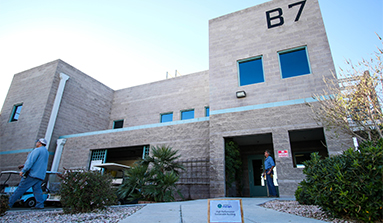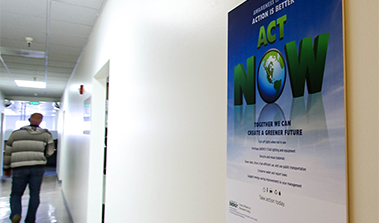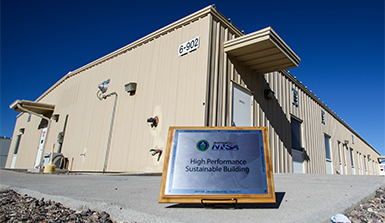
The National Nuclear Security Administration (NNSA) has certified four additional Nevada National Security Site (NNSS) buildings – Maintenance Facility, B-07; Field Engineering Building, 06-902; Area 6 Warehouse, 06-914; and Administration Facility, 23-118 – as high-performance sustainable buildings (HPSB).
“These buildings meet the 2008 Federal Guiding Principles for HPSB and exemplify high standards in integrated design, integrated management, energy and water efficiency, and enhanced indoor environmental quality,” said James J. McConnell, NNSA associate administrator for safety, infrastructure and operations, in a congratulatory letter accompanying official HPSB-status plaques, which will be displayed in each building.
McConnell noted that the plaques – sustainably made themselves, produced using bamboo and aluminum – “exemplify the best-in-class performance of the building, building operators and professionals who enable NNSA’s success.”
Additionally, McConnell wrote, “You should take great pride in this accomplishment. Fewer than seven percent of NNSA’s buildings can claim that they meet the HPSB ‘green’ building standard. We trust that the current and future occupants of these buildings will benefit from their high performance. You have clearly demonstrated our commitment toMission First, People Always.”
The achievement supports the Department of Energy’s goal to have 17 percent of its buildings meet sustainability certifications by 2025.

The 17 percent goal can be met by number or total square footage of an agency’s existing buildings above 5,000 gross square feet (GSF). Currently, 13 of the NNSS’ 109 buildings meet the requirement. NNSS owns or leases 109 buildings at and above 5,000 GSF, totaling 2,055,025 GSF. Nineteen of these buildings, or 349,354 GSF, represent the goal of 17 percent. The DOE’s original goal was 15 percent, but according to the DOE’s2016 Strategic Sustainability Performance Plan, that target was increased to 17 percent.
“Meeting this one particular goal, of many other sustainability goals, is an important part of the overall federal effort to improve the sustainability efforts at each of the Nuclear Security Enterprise (NSE) sites, one facility at a time, with an overall objective to educate our DOE employees on living ‘greener’ within their work environments,” said Savitra Candley, PMP, LEED AP O+M, who serves as an energy management manager for Mission Support and Test Services, LLC (MSTS), the management and operating contractor for the NNSS.
Without any extra effort, NNSS’ four buildings already met many of the criteria required for HPSB status. Because of their location, the buildings at the Site are naturally surrounded by desert landscaping, while the fourth building – located at the North Las Vegas Facility – already had desert landscaping thanks to a previous initiative that changed out all of the building’s grass. Additionally, the Site exceeds water reduction requirements, so no changes needed to be made on that front either.

To officially qualify for HPSB status, all four buildings received recycle centers, green educational signage, no smoking signage, retro-commissioning and validation of meeting ASHRAE (American Society of Heating, Refrigerating and Air-Conditioning Engineers) requirements. Only 23-118’s HVAC system proved to need some work, and it received new dampers in FY17.
“I have to clearly acknowledge that our success in working toward this goal has completely revolved around the expertise of our team plus many of our onsite SMEs (e.g., site maintenance and facility managers),” Candley said. “Without many of them, the progress to achieving this goal would not be possible; we are truly grateful for all the help and support we have received.”
The NNSS buildings earned the HPSB designations in accordance with standards outlined in Executive Order 13693,Planning for Federal Sustainability in the Next Decade, which outlines requirements federal agencies must implement to increase efficiency and improve environmental performance.
While bringing buildings built in 1988 (23-118), 1992 (B-07 and 06-914) and 1993 (06-902), respectively, to meet the current high performance criteria was no small task, the NNSS met the challenge through minimal targeted investment and operational adjustments.
